|
|

Crab Parasitism
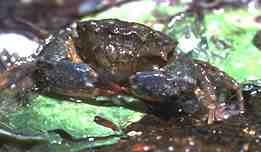
A male Smooth-handed Crab, Pilumnopeus serratifrons, can be parasitised by a species of shelless Barnacle Saccula sp. which lives part of its life cycle under the male's abdominal plate. The parasitic barnacle feeds on the living crab's tissue.
This barnacle is a rhizocephalan, which is parasitic on decapod crustaceans. Its body is sac-shaped, and the mantle never develops calcareous plates. It doesn't have any appendages or segments. Therefore, it never looks like a "normal" barnacle.
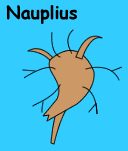 |
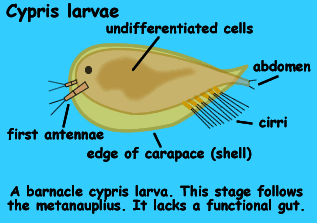 |
| After hatching, the first Sacculina sp. life stage is a nauplius. | After a couple of moults it becomes a cypris |
This barnacle's cyprid, which will grow to be a female, attaches itself by its first antennae to the base of the adult crab's setae.
The barnacle cyprid then excavates a hole through the carapace of the crab allowing the mass of cells to enter into the body of the crab.
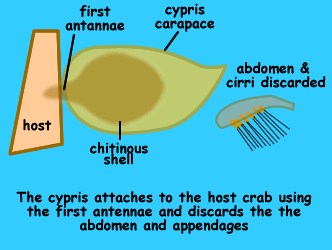
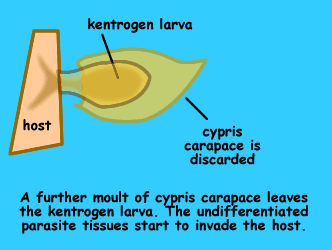
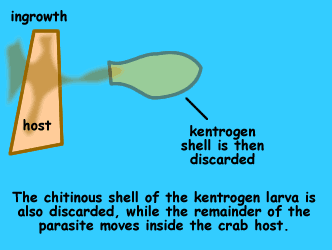
Illustrations based on diagrams in
Russell-Hunter. W.D. (1970) A Biology of Higher Invertebrates
Macmillan, London.
The barnacle feeds by having many outgrowths, called rhizoids, which grow and extend throughout the body of the crab, and take in food for the barnacle.
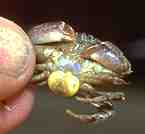 When
the barnacle is sexually mature, it creates a brood chamber which grows
out like a mushroom, through another opening near the base of the abdomen
(see photo at right)..
When
the barnacle is sexually mature, it creates a brood chamber which grows
out like a mushroom, through another opening near the base of the abdomen
(see photo at right)..
A male cyprid of the same species of barnacle attaches itself to the opening of this brood chamber, and then grows inside a special chamber within the female barnacle which itself is inside the body of the parasitised crab. This male growth forms into a testis. The female then effectively becomes a hermaphrodyte, which means that it can fertilise itself.
The effects of this parasitism on the adult crab is quite remarkable. The crab's ability to moult is inhibited. It also reduces or looses its ability to reproduce, and it gains female characteristics and appearance.
I have found a number of these parasitised male crabs near the heated water outflow of coal-fired power stations. The area near Erraring Power Station at Lake Macquarie, NSW is one such area.
References:
Barnes, R. D. (1968) Invertebrate Zoology. p. 467, W.B. Saunders Company, Philadelphia.
Bennett, I. (1987) W.J. Dakin's classic study: Australian Seashores. p.391, Angus & Robertson, Sydney.
Davey, K. (1998) A Photographic Guide to Seashore Life of Australia. p.52, New Holland, Sydney.
Jones, D. & Morgan, G. (1994) A Field Guide to Crustaceans of Australian Waters. p.182, Reed, Chatswood.
Russell-Hunter.
W.D. (1970) A Biology of Higher Invertebrates.
p. 80, Macmillan, London.
Crabs
Tubercled
Crab
Reef Crab
Smooth-handed Crab
Variegated
Shore Crab
Red Bait Crab
Sowrie Crab
Mudflat Sentinal Crab
Smooth Shore Crab
Seaweed-decorator
Crab
Crab
reproduction
Crab parasitism
Home
Page
Taxonomy
Biogeography
Rocky Shores
Tidal Levels
Intertidal Zonation
Environmental Factors
Biological
Factors
Feeding Relationships
Activities
Glossary
References
 Life
on Australian Seashores
Life
on Australian Seashores
by Keith Davey (C) 2000
Learning Consultant
- Media
The University of Newcastle
email at australian_seashores@hotmail.com
Scientific Consultant: Phil
Colman
site created 01.01.98 : updated 01.04.2000